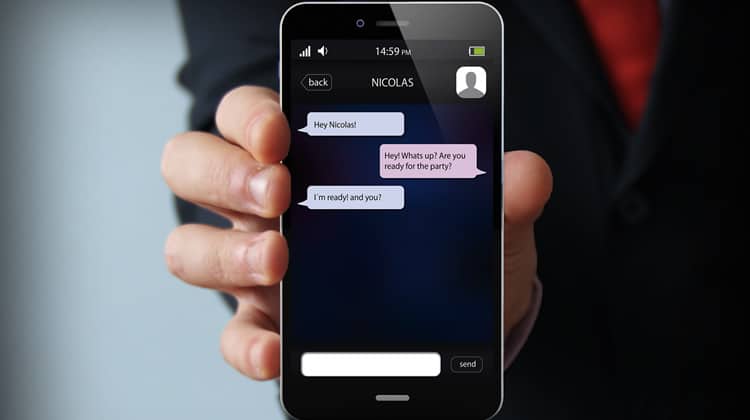
As a highly-connected, smartphone-addicted, broadband-blessed nation, you’d have thought the UK gadget-dependant phone user would be up to the minute with all of the latest digital gizmos and trends. However, new research suggests that the British are behind the times when it comes to smartphone instant messenger applications.
It’s a peculiar result. Instant messengers are generally free and allow us to communicate without using up our precious credit or contracted text quota. Nevertheless, UK users are lagging far behind Brazil and Russia where (respectively) 88% and 75% of smartphone users send messages via IM applications. By contrast, just 46% of British smartphone users are utilising applications like “What’s App” and “Nimbuzz”. Given how accessible and affordable mobile data is becoming thanks to a new breed of 3G providers who are building their business exclusively to target the mobile broadband niche, this lack of savviness regarding how best to get your money’s worth out of your sim card is an unexpected finding for the nation well known for their financial shrewdness.
What’s App with that?
So what’s the deal with the British people’s unusual lack of interest in these fast, money-saving apps? One factor could be the population’s median age. We’re an increasingly middle aged society here in the UK, 40.5 is our societal average. Meanwhile, in Brazil the median age is just 30.
As a population ages their adaptability and willingness to get to grips with new technology will decrease. As we get older as a nation, the speed at which we jump on technological bandwagons lessens. This is due to many factors but the most important observation to make is while the UK average is just over 40 years old this is still a generation well versed in computer literacy. “The internet” isn’t a new fad any longer to confuse and terrify the uninitiated. These 40 year olds know the virtues of the web and work with computers in their day job. In fact 35 year olds have been found to be the most common demographic of online gamer.
This would suggest that It may not be a lack of willingness to try new things, but rather that an older generation of web users simply aren’t aware of these apps and their money saving virtues. However the gulf between Brazilian and UK usage seems too significant to be down to generational gaps alone so let’s go deeper.
A whole other world…
Societal differences are likely to play the biggest part in how we use our smartphones across the world. The same survey, conducted by YouGov demonstrated that Russians, Brazilians, North Americans and Brits all have very different approaches to mobile devices and how they have been integrated into our digital cultures.
In the survey, which ranges across various age groups in the UK and Brazil, 42% of Brazilians claim to sleep next to their mobile phone. Just 21% of UK respondents claimed to be guilty of this modern bad habit. Meanwhile, 61% of British 18-24 year olds would rather forgo chocolate, alcohol, caffeine, a toothbrush and exercise for a week rather than go a year without the ability to text. 76% of young Brazilians meanwhile would be willing to do the same. These figures suggest that both countries are well on their way to sliding towards (an alarming?) border-line obsessive dependence on their smartphones, but the Brazilians are further down the slope than the Brits for now.
Who’s using what?
So now that we’ve identified the irreversible slide happening towards smart phone assimilation let’s have a look at who’s using what to communicate via smartphone IM apps in the UK? Well, if you’re using the well established Whatsapp, you’re in the majority. 50% of those polled who made use of the (now monetised) IM platform, closely followed by the 42% who utilised Facebook Messenger. Twitter and iMessage were less popular but still present as IM apps.
Get messaging
Want to make use of an IM app yourself? Why not? It’s great! Free, fun and fast too. It also gives you far more options regarding how you communicate. Send voice recordings, take and instantly send photos, send your location, send video – there’s a lot more freedom than most standard SMS services.
So which are the best to use? It really depends on what your friends use – this will put you in direct contact with your pals. As a rule of thumb, however, here are the top, most popular options:
What’s App
This is the dominant UK IM app, so chances are your friends are using it already. It has a year long free trial, then costs $1 per year. With voice chat, location sharing, video sharing, image sharing and much more – it’s a very sweet deal.
iMessage/Facetime
This is Apple’s IM app offering and it’s taken its sweet time getting to the market. Now it’s here, it’s steadily building users and works really well – not compatible with non-Apple handsets though, which is a pain.
Google Hangouts
A nice one from Google. Available across all platforms with a growing base of users. Also integrated with Google+ which makes it convenient and particularly handy for businesses who want to video chat on the move.
Want to learn more?
Are you interested in the intersection between UX and UI Design? The online courses on UI Design Patterns for Successful Software and Design Thinking: The Beginner’s Guide can teach you skills you need. If you take a course, you will earn an industry-recognized course certificate to advance your career. On the other hand, if you want to brush up on the basics of UX and Usability, try the online course on User Experience (or another design topic). Good luck on your learning journey!
(Lead image: Depositphotos)
